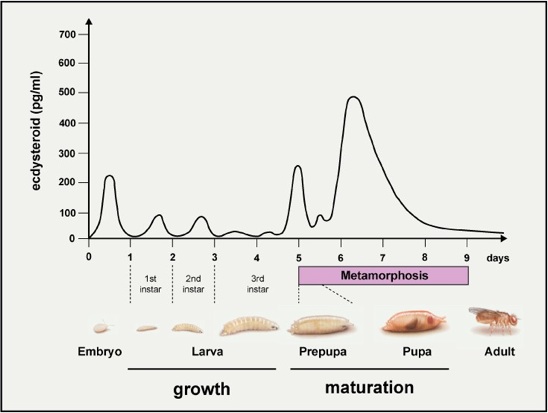Steroid Hormone Signaling: Ecdysone as a paradigm


If one takes a closer look at the life cycle of the fruit fly, one quickly realizes that its growth is restricted to the three larval stages and that maturation occurs during metamorphosis. This temporal separation raises a central question: how does a larva decide that it has grown enough and that it is time to move on to maturation? What are the genes and hormones involved in this decision? Part of the answer can be found by examining pulses of the steroid hormone ecdysone, which trigger each of the major developmental transitions, including the two molts and puparium formation (see the figure). During metamorphosis the entire organism is remodeled until a sexually mature fly ecloses. Importantly, the energy required for metamorphosis has to be stored during larval stages, which is why larvae have to grow beyond a certain threshold weight to sustain this process. This threshold weight is the so-called critical weight. Roughly a day after this checkpoint is fulfilled, a small pulse of ecdysone will trigger the termination of feeding and the start of wandering behavior, which will eventually result in a late larval ecdysone peak and the onset of metamorphosis.
How does a larva measure its own weight? This question is far from trivial and still not well understood. We have identified a mutation in a nuclear receptor gene called DHR4, which appears to be responsible for disrupting the animals’ ability to pupariate at the correct body size and weight. In addition, a disruption of DHR4 function can result in the premature onset of wandering behaviour as well as puparium formation, indicating that this nuclear receptor is critical for developmental timing as well.
DHR4 acts directly downstream of the receptor for ecdysone, which is called - not too surprisingly - the Ecdysone Receptor (short: EcR), which is also a nuclear receptor. However, we are more interested in the role of DHR4 in pathways that control critical weight. We are currently examining phenotypes associated with tissue-specific disruption and overexpression of this receptor, and are employing genomic strategies to determine which processes are regulated by this nuclear receptor.
The life cycle of a fly in the context of changing steroid hormone titer (here ecdysone, a so-called ecdysteroid). The fruit fly develops through three larval stages before it reaches puparium formation. The larval stages are separated by molts, which are controlled by pulses of ecdysone. Other major development events, such as hatching and the transition from a larva to a pupa, are also controlled by this hormone.


